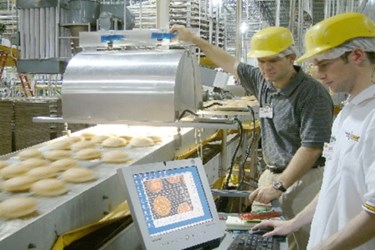Food Inspection: New Technologies Are Ensuring Better Detection
By Melissa Lind, contributing writer

It’s not just machinery providing advancement in food inspection, some solutions have been provided by simple, fresh innovations.
The development of technology solutions in the food industry is making the detection of food contaminants much easier. These technologies are providing better protection not only in terms of increased safety, but are also a major financial incentive by preventing recalls, unnecessary processing-line stoppages and delays, and preserving brand loyalty.
Metal detection has expanded beyond simple magnetics systems, which can detect ferrous metal fragments. Today’s technology utilizes an array of frequencies to detect smaller particles of a variety of ferrous and non-ferrous metals, along with stainless steel. The spectrum of frequencies operates simultaneously and continuously to increase contaminant detection and reduce false rejects. All of these combine for great efficiency across processing packaging lines.
X-Ray inspection, for many companies, is the “multi-tool” in the tool belt. It provides the ability to detect a wide range of hard-body contaminants including glass, metal, stone, bone, and high-density plastics. X-Ray systems can also detect improper placement, missing or incorrectly placed packaging components, improper seals, and inconsistent fill amounts. In addition, new developments also allow for detection of some lower-density contaminants. These systems require minimal training with automatic performance and can operate with high-speed and multi-line packaging systems.
Metal Detection? X-Ray Inspection? Both? Learn what’s best for your needs…
Many manufacturers have developed bright, color-coded components as a method of avoiding non-food items in the processing line. However, these will likely still require direct human observation. In addition to the flexibility allowed by X-Ray inspection systems, in terms of contaminant variety, system placement and other assets, components are being developed to easily show as a contaminant on X-Ray systems. Most companies have relied on “no pocket” rules and such to prevent personal items from entering the food line, but newer components are decreasing the chance that items such as pens, Band-Aids, or hairnets will fall into the processing line.
X-Ray visible components can be developed for many manufacturing plant needs including:
- Bandages
- Hair Ties/Hair Nets
- Pens/Touch Screen Styluses
- Gloves
- Tie-Wraps
- Replaceable Machine Components
- Tags/Markers
Innovative companies have sprung up to manufacture a stock inventory of commonly-needed items, but are also able to manufacture custom products with strategies for easy identification to prevent food contamination. This is revolutionary as it not only maintains the current applicability and advantages of X-Ray equipment, but expands it to increase safety and prevent liability and public confidence crises that can come from one single event of a personal item or contaminant falling into a food product.
